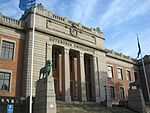Viktoria Institute
Viktoria Swedish ICT (previously Viktoria Institute) was founded in 1997 at the initiative of the local industry in West Sweden. The task is to perform research and development in applied information technology in collaboration with industry, the public sector, and academic institutions. The goal is to help Swedish automotive and transport industry achieve sustainable development and growth.
Viktoria works for making sure that research results and IT applications are disseminated rapidly, come to practical use and contribute to sustainable development of products, services, business and companies. All research projects are funded through competitive applications to, for example, The Swedish Foundation for Strategic Research, Swedish Agency for Innovation Systems, The Knowledge Foundation, The Swedish Research Institute for Information Technology and the EU. This has resulted in high-quality research and a very good reputation of the institute in Sweden and internationally.
By working closely with industry partners, Viktoria will develop user oriented, innovative services, which will have the advantage of being commercially well packaged from the very beginning. Indeed, Viktoria will play the role as supplier of specifications, as well as inspirational source to the companies developing platforms and services. In this way, Viktoria will provide a neutral arena for experimenting with and negotiating innovative solutions.
Today, about 50 people work at Viktoria. Viktoria is structured into five main application areas and two competence centers: Cooperative Systems, Digitalization Strategy, Electromobility, Sustainable Business and Sustainable Transports. Each research area is managed by a senior researcher (PhD or professor).
The Automotive competence area covers applied research with industry actors targeting IT applications and services that are based, or partly based, on in-vehicle computing and communication platforms. Examples of application areas include active safety, diagnostics or remote diagnostics, and nomadic device integration.
The transport competence area covers applied research with industry actors targeting IT applications that support transportation practices. Utilizing mobile devices embedded in vehicles or held by users, open accessible sensor-data, and stationary systems placed in the infrastructure, three examples of IT application areas in the road transport industry are transport management, intelligent transports for people and goods, and remote vehicle diagnostics.
History
The institute was founded as a spin-out from the University of Gothenburg in 1997 as the result of an initiative taken by industry mainly from West Sweden and some academics from Gothenburg. The institute started in 1997 with seven employees, but expanded to 15 people within the first year of its existence and performed research in the following areas:
- IT & Organization (later divided into the two areas Business Technology and Knowledge Management),
- Mobile Informatics,
- Ubiquitous computing.
The institute was organized as a private joint-stock company, owned by the West Sweden IT Association (a non-profit association for corporate members), the University of Gothenburg, and Chalmers University of Technology. Research financing was received through annual membership fees of corporate members, mission oriented research, and public research funds.
The original location was a building shared with the university's department of Informatics at Viktoriagatan 13 in the center of Gothenburg. The street address also gave name to the institute. After the establishment of Lindholmen Science Park in Gothenburg, the institute moved there, sharing its new premises with the IT University.
As part of the re-organization of IT research in Sweden in 2003, the institute was incorporated into the SICS group, a national holding organization for IT research, comprising the Swedish Institute of Computer Science, the Interactive Institute, the Santa Anna Research Institute and the Viktoria Institute. Since 2005, the SICS group been part of a new organization, Swedish ICT Research AB (SICT). SICT is a private joint-stock company, owned by the Swedish state through its holding company IRECO (60%) and two industry associations (20% each).
External links
| ||||||||||||||||||||||
| ||||||||||||||||||||
